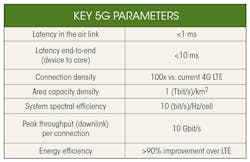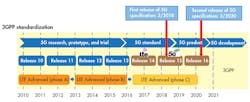Download this article as a .PDF
Fifth-generation (5G) networks are the next major phase of mobile telecommunications beyond the current 4G LTE standards. 5G technology needs to be specified, developed, and deployed by a variety of industry players, including network equipment vendors, network operators, semiconductor vendors, device manufacturers, and electronic test-and-measurement equipment makers.
There has been much discussion of how 5G will transform products ranging from mobile phones to next-generation automobiles. What isn’t widely understood are the specific technologies that will make 5G different from 4G LTE. Let’s take a look at the technology changes that are underway as the industry shifts from the 4G LTE standard to 5G.
5G Demand Drivers
Two major trends are behind the rapid investment in 5G development. The first is the exponential growth in demand for wireless broadband networks capable of carrying video and other content-rich services. The second is the Internet of Things (IoT), where a large number of smart devices communicate over the internet. To achieve these objectives, 5G will provide extreme broadband speed, ultra-low latency, and ultra-reliable web connectivity based on Internet Protocol (IP; Fig. 1).
By providing higher bandwidth capacity than current 4G-enabled network capabilities, 5G will enable a higher density of mobile broadband users and support ultra-reliable device-to-device and massive machine communications with the following features.
- Enhanced Mobile Broadband (eMBB) for high-capacity and ultra-fast mobile communications for phones and infrastructure, virtual and augmented reality, 3D and ultra-HD video, and haptic feedback.
- Ultra-reliable and Low Latency (URLLC) for vehicle-to-vehicle (V2V) and vehicle-to-infrastructure (V2I) communications and autonomous driving.
- Massive Machine-Type Communications (mMTC) for consumer and industrial IoT and Industry 4.0 mission-critical machine-to-machine (MC-M2M) communication.
When Can We Expect 5G?
The 3GPP standardization group defines the wireless 5G standard, with help from many participants and contributors around the globe. Release 15 of the 3GPP standard, expected by March 2018, will introduce the 5G standard (Fig. 2). Modulation schemes, beamforming techniques, millimeter-wave technology, and massive multiple-input, multiple-output (MIMO) architectures are expected to be significantly different from current 4G technologies.
Current 5G research and development focuses on these enabling technologies, including hybrid beamforming, millimeter-wave and massive MIMO systems, 5G channel modeling and waveforms, and rapid field trials of 5G design concepts. This 5G physical layer will depart from 4G LTE in a number of ways, so as to improve spectral efficiency and data rates.
One distinctive feature is a significant jump in the number of active antennas and antenna arrays, and the related issues of beamforming and millimeter-wave RF signal processing. New modulation and coding schemes, power and low-noise amplifier designs, and channel models all need to be developed. Let’s take a closer look at the technologies that will play a key role in the arrival of 5G.
Physical Layer Algorithms and Channel Models
Researchers and engineers contributing to the 5G standard form working groups to study, propose, and select technologies to achieve the goals of the new standard. These working groups have already defined important aspects of the new 5G physical layer, including:
- Channel models, including tapped delay line (TDL) and clustered delay line (CDL) channel models as specified in 3GPP TR 38.901
- New radio waveforms to improve spectral efficiency by limiting out-of-band emissions, including Filtered OFDM (F-OFDM), Windowed OFDM (W-OFDM), and Cyclic Prefix OFDM (CP-OFDM)
- New coding schemes such as LDPC for data and polar codes for control information, error correction, and improved data rates
- Link-level simulation reference design, enabling one to measure the throughput of a 5G link using the provided waveforms and channel models
Millimeter-Wave: Higher-Frequency Operation
Higher data rates (multi-Gbps) drive the need for wide-bandwidth systems. However, the available bandwidth in the spectrum up through 6 GHz is not sufficient to satisfy these requirements (current cellular operation is below 3 GHz). This has moved the target operating frequency bands up into the millimeter-wave range for the next generation of wireless communication systems. For example, 5G equipment developers such as Huawei and Nokia have announced 5G New Radio (NR) trials with AT&T, Verizon, China Mobile, NTT DOCOMO, and others. Those trials will operate in the midband spectrum from 3.3 to 5.0 GHz, as well as the millimeter-wave spectrum at 28 GHz and 39 GHz, showcasing the unified 3GPP-based 5G NR design across diverse spectrum bands.
High frequencies will provide larger bandwidth availability and smaller antenna dimensions for a fixed gain, or higher gain for a given antenna size. However, this increases modem complexity in baseband and RF designs. To study the performance, an accurate channel model for the new frequencies in 5G is needed.
Massive MIMO: More Antennas
Another key technology for achieving greater spectral efficiency is massive MIMO. Massive MIMO, sometimes referred to as large-scale MIMO, is a form of multi-user MIMO in which the number of antennas at the base station is much larger than the number of devices per signaling resource. The large number of base-station antennas relative to user devices results in a channel response that is quasi-orthogonal and has the potential to yield huge gains in spectral efficiency.
Such conditions would enable many more devices to be served with the same frequency and time resources within a given cell compared to modern-day 4G systems. Designers face a challenge when scaling the number of antennas into the hundreds:
- The simulation speed of traditional antenna design tools is slow for large antenna arrays.
- It is difficult to simulate antenna coupling.
- Hybrid beamforming is needed to optimize the increased number of RF chains.
Fast Prototyping of 5G Systems with Hardware Testbeds
Engineers working on 5G designs have realized the value of rapid design iterations and of quickly placing proof-of-concept prototypes in field trials. Hardware testbeds employed as flexible and reconfigurable design platforms have proven to be dependable and efficient for the rapid design and verification of new concepts, as well as for their deployment in pre-commercial field trials. The tools and workflows that interface to testbeds must support rapid design iterations and rapid deployment of new algorithms or design changes. Software tools like MATLAB and Simulink provide engineers with tools to help study and develop the 5G standard, such as channel models, new radio waveforms, new coding schemes, and link-level simulation reference design.
As the wireless industry anticipates the final result of 3GPP standardization process, engineers are already at work exploring, prototyping, and testing the enabling technologies of 5G.



